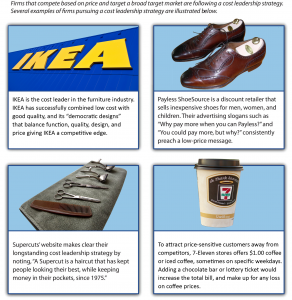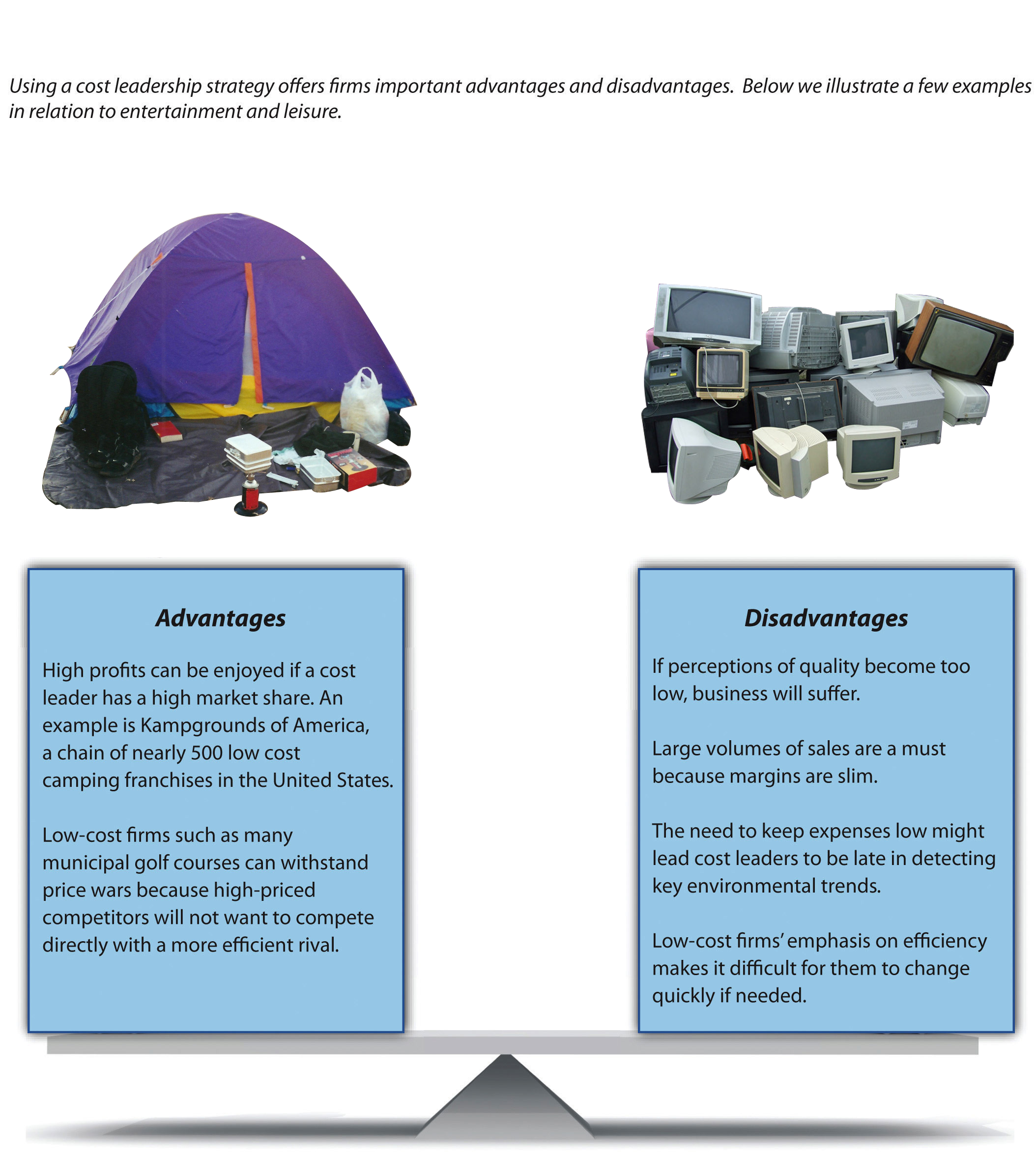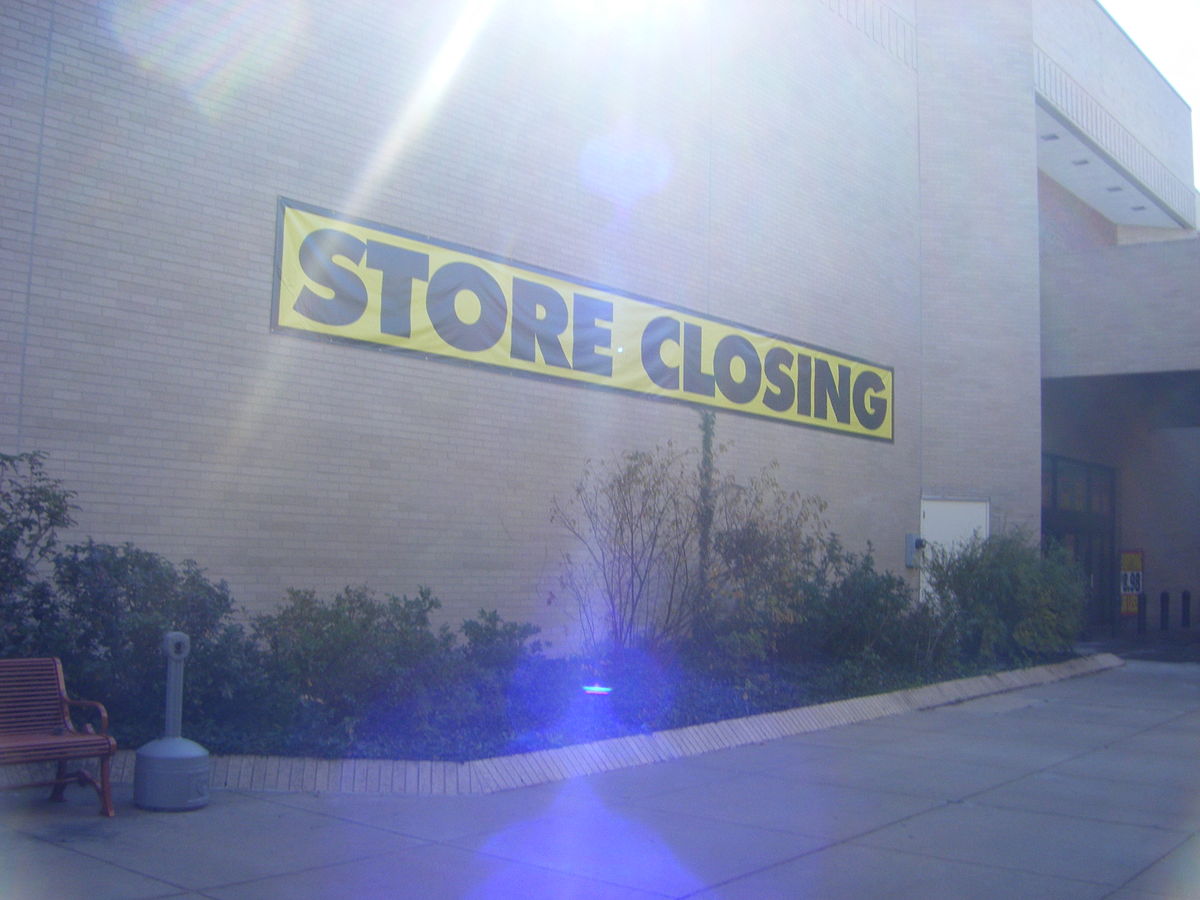Chapter 5: Selecting Business-Level Strategy
Cost Leadership
Learning Objectives
- Describe the nature of cost leadership.
- Understand how economies of scale help contribute to a cost-leadership strategy.
- Know the advantages and disadvantages of a cost-leadership strategy.
The Nature of the Cost-Leadership Strategy
It is tempting to think of cost leaders as companies that sell inferior, poor-quality goods and services for rock-bottom prices. The Yugo, for example, was an extremely unreliable car that was made in Eastern Europe and sold in the United States for about $4,000 in the 1980s. Despite its attractive price tag, the Yugo was a dismal failure because the car was so poorly made that drivers simply could not depend on the car for transportation. Yugo exited North America in the early 1990s and closed down entirely in 2008.

In contrast to firms such as Yugo whose failure was inevitable, cost leaders can be very successful. A firm following a cost leadership strategy offers products or services with acceptable quality and features to a broad set of customers at a low price (Figure 5.3 “Cost Leadership”). This combination of an appropriate price and value is sometimes referred to as a strong value proposition. Payless ShoeSource, for example, sells name-brand shoes at inexpensive prices. Its low-price strategy is communicated to customers through advertising slogans such as “Why pay more when you can Payless?” and “You could pay more, but why?”
Firms engaging in cost-leadership strategy seek to combine low per-unit profit with large sales to make a profit. Typically, but not always, they tend to market to a large population base or a niche with a high demand volume.

Perhaps the most famous cost leader is Walmart, which has used a cost-leadership strategy to become the largest company in the world. The firm’s advertising slogans such as “Always Low Prices” and “Save Money. Live Better” communicate Walmart’s emphasis on price slashing to potential customers. Meanwhile, Walmart has the broadest customer base of any firm in North America. Approximately 100 million of us visit a Walmart in a typical week (Zimmerman & Hudson, 2006). Incredibly, this means that roughly one-third of Americans are frequent Walmart customers. This huge customer base includes people from all demographic and social groups within society.
In 2014, Walmart faced stiff completion from dollar store chains coupled with growing competition from Amazon.com and Internet shopping as more and more people shop online. Walmart has been sharpening its focus on everyday low prices and further pushing that strategy abroad. Interestingly, Walmart’s success has been somewhat limited in their international expansion efforts. Having exhausted the potential sales market for big-box stores, with over 90 percent of North Americans living within fifteen minutes of a Walmart, the company is planning to accelerate growth plans for smaller Neighborhood Markets and Walmart Express stores that cater to shoppers looking for more convenience with fresh produce and meat and household and beauty products (Anderson, 2014).
Cost leaders tend to share some important characteristics. The ability to charge low prices and still make a profit is challenging. Cost leaders manage to do so by emphasizing efficiency at every step of the value chain: production, manufacturing, sales, and customer service. At Smitty’s Restaurants, for example, customers are served cheap meals quickly to keep booths available for later customers. As part of the effort to be efficient, most cost leaders spend little on advertising, market research, or research and development. Smitty’s, for example, limits its advertising to billboards along highways, a $2 membership card for 10 percent discounts, and its website. Meanwhile, the simplicity of Smitty’s menu requires little research and development. Walmart spent approximately $2.3 billion on advertising in 2013. This is a huge number, but Walmart is so large that its advertising expenses equal just a tiny fraction of its sales.
Many cost leaders rely on economies of scale to achieve efficiency. Economies of scale are created when the cost of goods and services decreases as a firm is able to increase production. Most companies do experience some economics of scale initially; for a coffee shop, the most expensive cup of coffee they make every day is the first! However, for some firms such as a new hydro generation plant or the latest Lady Gaga CD, there are huge start-up or fixed costs (think, the cost of making the first Lady Gaga CD is maybe $250,000; the second, one cent; the third, one cent…). The average costs fall the more electricity is generated or CDs are printed—economies of scale.
When cost leaders become large companies, it can give them sufficient market power to demand price concessions from their suppliers. Walmart is notorious for requiring suppliers, such as Procter & Gamble, to sell goods to Walmart for lower and lower prices over time. In its defence, Walmart invests considerable resources and efforts to help suppliers find ways to reduce costs. Walmart then seeks to pass on most of these savings to customers in the form of reduced prices.
Advantages and Disadvantages of Cost Leadership
Each generic strategy offers advantages that firms can potentially leverage to enhance their success as well as disadvantages that may undermine their success. In the case of cost leadership, one advantage is that cost leaders’ emphasis on efficiency makes them well positioned to withstand price competition from rivals (Figure 5.5 “Executing a Low-Cost Strategy”). Kmart and Zellers’s ill-fated attempt to engage Walmart in a price war ended in disaster, in part because Walmart was so efficient in its operations that it could live with smaller profit margins far more easily than Kmart or Zellers could.

Beyond existing competitors, a cost-leadership strategy also creates benefits relative to potential new entrants. Specifically, the presence of a cost leader in an industry tends to discourage new firms from entering the business because a new firm would struggle to attract customers by matching or even undercutting the cost leaders’ prices. Thus a cost-leadership strategy helps create barriers to entry that protect the firm—and its existing rivals—from new competition.

In many settings, cost leaders attract a large market share because a large portion of potential customers find paying low prices for goods and services of acceptable quality to be very appealing. This is certainly true for Walmart, for example. The need for efficiency means that cost leaders’ profit margins are often slimmer than the margins enjoyed by other firms. However, cost leaders’ ability to make a little bit of profit from each of a large number of customers means that the total profits of cost leaders can be substantial.
In some settings, the need for high sales volume is a critical disadvantage of a cost-leadership strategy. Highly fragmented markets and markets that involve a lot of brand loyalty may not offer much of an opportunity to attract a large segment of customers. In both the soft-drink and beer industries, for example, customers appear to be willing to pay a little extra to enjoy the brand of their choice. Lower-end brands of soda and beer appeal to a minority of consumers, but famous brands such as Coca-Cola, Pepsi, Budweiser, and Molsons still dominate these markets. A related concern is that achieving a high sales volume usually requires significant upfront investments in production and/or distribution capacity. Not every firm is willing and able to make such investments.
Cost leaders tend to keep their costs low by minimizing advertising, market research, and research and development, but this approach can prove to be expensive in the long run. A relative lack of market research can lead cost leaders to be less skilled than other firms at detecting important environmental changes and trends. Meanwhile, downplaying research and development can slow cost leaders’ ability to respond to changes once they are detected. Lagging rivals in terms of detecting and reacting to external shifts can prove to be a deadly combination that leaves cost leaders out of touch with the market and out of answers.
Key Takeaways
- Cost leadership is an effective business-level strategy to the extent that a firm offers low prices, provides satisfactory quality, and attracts enough customers to be profitable.
Exercises
- What are three industries in which a cost-leadership strategy would be difficult to implement?
- What is your favourite cost leadership restaurant?
- Name three examples of firms conducting a cost-leadership strategy that use no advertising. Should they start advertising? Why or why not?
References
Anderson, M. (2014, May 15). Poor weather dents Wal-Mart 1Q results; 2Q earnings forecast misses analysts’ expectations. Retrieved from http://www.winnipegfreepress.com/business/bad-weather-hurts-wal-mart-in-1q-gives-2q-earnings-forecast-below-analysts-expectations-259358851.html
Zimmerman, A., & Hudson, K. (2006, April 17). Managing Wal-Mart: How US-store chief hopes to fix Wal-Mart. Wall Street Journal.
Image descriptions
Figure 5.3 image description: Cost Leadership
Firms that compete based on price and target a broad target market are following a cost leadership strategy. Several examples of firms pursuing a cost leadership strategy are illustrated below.
- IKEA is the cost leader in the furniture industry. IKEA has successfully combined low cost with good quality, and its “democratic designs” that balance function, quality, design, and price giving IKEA a competitive edge.
- Payless ShoeSource is a discount retailer that sells inexpensive shoes for men, women, and children. Their advertising slogans such as”Why pay more when you can Payless?” and”You could pay more, but why?” consistently preach a low-price message.
- Supercuts’ website makes clear their longstanding cost leadership strategy by noting, “A Supercut is a haircut that has kept people looking their best, while keeping money in their pockets, since 1975.”
- To attract price-sensitive customers away from competitors, 7-Eleven stores offers $1.00 coffee or iced coffee, sometimes on specific weekdays. Adding a chocolate bar or lottery ticket would increase the total bill, and make up for any loss on coffee prices.
Figure 5.5 image description: Executing a Low-Cost Strategy
Using a cost leadership strategy offers firms important advantages and disadvantages. Below we illustrate a few examples in relation to entertainment and leisure.
- Advantages
- High profits can be enjoyed if a cost leader has a high market share. An example is Kampgrounds of America, a chain of nearly 500 low cost camping franchises in the United States.
- Low-cost firms such as many municipal golf courses Can withstand price wars because high-priced competitors will not want to compete directly with a more efficient rival.
- Disadvantages
- If perceptions of quality become too low, business will suffer.
- Large volumes Of sales are a must because margins are slim.
- The need to keep expenses low might lead cost leaders to be late in detecting key environmental trends.
- Low-cost firms’ emphasis on efficiency makes it difficult for them to change quickly if needed.
Media Attributions
- Figure 5.3: Attribution information for all included images is in the chapter conclusion.
- Yugo © Antp is licensed under a CC BY-SA (Attribution ShareAlike) license
- Figure 5.5: Attribution information for all included images is in the chapter conclusion.
- Store closing banner, S&B, Southwest Plaza © Bradley Gordon is licensed under a CC BY (Attribution) license
Generic strategy that offers products or services with acceptable quality and features to a broad set of customers at a low price.
A cost advantage created when a firm can produce a good or service at a lower per unit price due to producing the good or service in large quantities.

